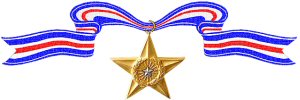Burt A. Bartley Silver Star citation
THE UNITED STATES OF AMERICA
ESTABLISHED BY AN ACT OF CONGRESS 9 JULY 1918 (AMENDED BY ACT OF 25 JULY 1963) AND AWARDED BY THE
PRESIDENT OF THE UNITED STATES OF AMERICA
SILVER STAR MEDAL
PRESENTED TO
LIEUTENANT COLONEL BURT ALLEN BARTLEY
UNITED STATES AIR FORCE
The President of the United States of America, authorized by Act of Congress July 9, 1918 (amended by an act of July 25, 1963), takes pleasure in presenting the Silver Star to Lieutenant Colonel Burt Allen Bartley, United States Air Force, for heroism and courageous action as F-16CG Flight Lead, 18th Fighter Squadron, during Operation ANACONDA in Afghanistan, on 4 March 2002, in support of Operation ENDURING FREEDOM. Upon learning of a downed MH-47 helicopter, Lieutenant Colonel Bartley departed assigned airspace to immediately support the recovery of thirty-nine personnel on board. En route to the site, Lieutenant Colonel Bartley established deconfliction with two Unmanned Aerial Vehicles (UAV) and two F-15Es near the crash site to provide maximum support to the rescue effort. With the F-15Es out of ammunition, Lieutenant Colonel Bartley immediately employed 20-mm. cannon fire to neutralize the enemy troops that were directly firing upon the survivors. He made two strafing runs with little regard for his own safety into rapidly rising mountainous terrain, and directly in the face of the same small arms fire that downed the helicopter. He then provided a rapid talk-on to his wingman, who was experiencing radio problems, to suppress the advancing enemy troops. His skill and determination forced the enemy troops to stop the attack on the downed helicopter crew and friendly forces and concentrate on digging in for cover approximately 50 meters from the crashed MH-47. After expending all 500 rounds of 20-mm. ammunition he stayed with the Ground Forward Air Controller (GFAC) on the radio while his wingman passed all critical information to command and control assets and located the tanker. His actions resulted in the flight’s ability to maintain continuous contact with the GFAC and continue to threaten the advancing enemy forces for over two and a half hours. Upon returning to the crash site, the GFAC reported that the previously pinned down enemy had begun to close in on their position again. After his wingman had verified from command and control that no other airborne assets had 20-mm. or light ordnance, Lieutenant Colonel Bartley informed the GFAC of the impending danger and at the GFAC’s request dropped 500 pound bombs within 100 meters of the crash site in order to keep the enemy forces at bay. Meanwhile, a second GFAC reported two more critically wounded soldiers requiring immediate evacuation. Lieutenant Colonel Bartley pinned down the enemy, and directed his wingman to coordinate for the air evacuation. He offered to escort the helicopters through the area with numerous small arms threats and Rocket Propelled Grenades. His quick thinking and superior coordination allowed friendly forces to maintain a secure location in extremely close proximity to the impact points and undoubtedly saved the lives of 21 uninjured survivors and 10 wounded in the crash site, and enabled the safe recovery of all 39 Americans. The undaunted leadership, extreme heroism and courageous actions of Lieutenant Colonel Bartley are consistent with the highest traditions of the United States Air Force. With survivors pinned down by enemy fire, two orbiting F-15E crews out of ordnance, and flying in mountainous terrain under constant small arms fire, Bartley made two strafing runs to help neutralize enemy positions and allow survivors to find cover and care for the wounded. After refueling, he immediately returned to the site, coordinated with the ground forward air controller, and conducted a series of bombing runs, closing to within one hundred meters of the crash site. Bartley protected the survivors for more than two hours. He ensured that two critically injured soldiers were safely airlifted out and provided close air support for ground troops and cover for rescue helicopters until reinforcements arrived. His outstanding airmanship in an extreme combat environment led to the recovery of thirty-nine American soldiers.
